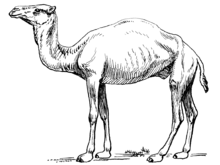Paracamelus
| Paracamelus Temporal range: Pliocene–Pleistocene | |
|---|---|
 | |
| Scientific classification | |
| Kingdom: | Animalia |
| Phylum: | Chordata |
| Clade: | Synapsida |
| Class: | Mammalia |
| Order: | Artiodactyla |
| Family: | Camelidae |
| Tribe: | Camelini |
| Genus: | †Paracamelus Schlosser (1903) |
| Species | |
| |
Paracamelus is an extinct genus of terrestrial herbivore of the family Camelidae, endemic to Africa, Europe, and Asia from the Pliocene through Pleistocene 5.33 mya—781,000 years ago existing for approximately 4.519 million years.[1] Examples of Paracamelus include the High Arctic camel reported in 2013.
Taxonomy
Paracamelus was named by Schlosser (1903). Its type is Paracamelus gigas. It was assigned to Camelidae by Carroll (1988).[2]
Fossil distribution
Fossil distribution ranged from Spain to Chad, Northern Africa to Shanxi Province, China.
References
- ↑ PaleoBiology Database: Paracamelus, basic info
- ↑ R. L. Carroll. 1988. Vertebrate Paleontology and Evolution. W. H. Freeman and Company, New York 1-698
This article is issued from Wikipedia - version of the 11/17/2016. The text is available under the Creative Commons Attribution/Share Alike but additional terms may apply for the media files.